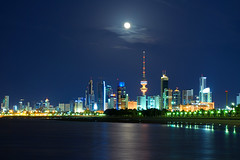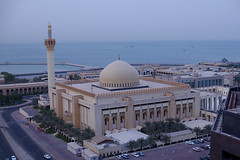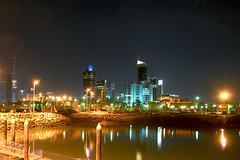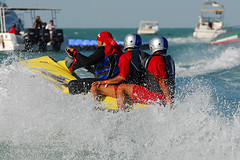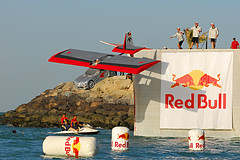Even though this picture took some planning and patience, in the end, it was a result of many factors coming together to result in one of my best night-time exposures.
1. My tripod was acting a little wobbly, so just before taking this shot, I visited the shop from where I purchased it, and the wizard there magically made it into a rock-solid tripod.
2. I had observed that it was a full moon the night before so I knew it would be almost full moon on this night - and the moon would rise at just the right time (around 7 p.m.).
3. The weather has been absolutely fantastic the previous night when I took this picture, and it appeared that the same would repeat again.
I was technically sick but I was not letting an opportunity like this pass me by. I packed my gear and headed towards the KPC building which provides one of the better viewpoints of Kuwait City. I arrived at the exact moment that the moon poked it's head over the buildings and I started clicking away - varying my shutter speed between 10 seconds to 30 seconds (maximum possible on my dSLR, without switching to bulb mode).
My only problem was the strong breeze that was whipping around. Even with the solid tripod, I was worried it would cause blur in the pictures. Luckily, most turned out pretty well.
Here are the 3 that seemed to be the better of the lot.
Photography is one of my passions (fitness being the other). This blog is focused on anything and everything to do with photography.
Tuesday, November 27, 2007
Sunday, November 25, 2007
Museums in Kuwait
A local advertising company found my work through Flickr, and approached me to do a series of photos on various places of interest in Kuwait.
I jumped at the opportunity because, for some reason or another, I had never visited most of these places in my 15 years in Kuwait. I was provided a list of places to photograph. Some of them were the usual suspects like Kuwait Towers, Liberation Towers, Scientific Center etc., for which I already had some some good pictures. The second list was exclusively for museums, which I had never visited.
So during the weekend, I packed my photo gear and headed out with my son in tow (he loves to accompany me on my photo shoots). We first reached the Memorial museum (next to the KPC building in Shuwaikh). The place looked deserted and closed. After poking around the place a bit, we found one lady who assured us the museum was indeed open - and after paying the KD 1 entrance fee, opened the museum just for us!. The museum was very interesting with a sort of an automated guided tour describing the whole Iraq invasion / atrocities commited / liberation etc. through an audio commentary accompanied by mock setups.
This pretty much described the reception that we got in the other museums that we visited (Al Hashemi II marine museum, Tareq Rajab Museum, and the biggest of them all - the National Museum). In all the places, it looked like we were the only people who visited the museum that day, which is a shame really because there is some really fascinating stuff there.
I will visit all these museums once again - but this time, without the camera equipment so that I can appreciate them better.
I jumped at the opportunity because, for some reason or another, I had never visited most of these places in my 15 years in Kuwait. I was provided a list of places to photograph. Some of them were the usual suspects like Kuwait Towers, Liberation Towers, Scientific Center etc., for which I already had some some good pictures. The second list was exclusively for museums, which I had never visited.
So during the weekend, I packed my photo gear and headed out with my son in tow (he loves to accompany me on my photo shoots). We first reached the Memorial museum (next to the KPC building in Shuwaikh). The place looked deserted and closed. After poking around the place a bit, we found one lady who assured us the museum was indeed open - and after paying the KD 1 entrance fee, opened the museum just for us!. The museum was very interesting with a sort of an automated guided tour describing the whole Iraq invasion / atrocities commited / liberation etc. through an audio commentary accompanied by mock setups.
This pretty much described the reception that we got in the other museums that we visited (Al Hashemi II marine museum, Tareq Rajab Museum, and the biggest of them all - the National Museum). In all the places, it looked like we were the only people who visited the museum that day, which is a shame really because there is some really fascinating stuff there.
I will visit all these museums once again - but this time, without the camera equipment so that I can appreciate them better.
Wednesday, November 21, 2007
It's all about Perspective
We've all seen pictures like this. They suffer from a phenomenon called perspective distortion. This happens when you take a camera and point it in such a way that the lens is not parallel with the ground. For e.g., when we find a building that is high, our tendency is to point the camera upwards. This distorts the image and it feels as though the building is going to fall down.
Perspective distortion happens because the lens is not able to resolve straight lines as straight due to the angle at which the lens is positioned. For architechture photography, this type of distortion is not acceptable, and photographers use specialized lenses called perspective correction lenses.
Since a normal user will not use PC lenses, Here are some ideas to avoid perspective distortion in your pictures.
1. Instead of shooting from up close, try to find a location further from the subject and use a telephoto lens to take the picture.
2. Shoot with perspective distortion and then edit in Photoshop. PS has a feature that allows you to do perspective correction.
In this picture, you can clearly see the perspective distortion as the tower of the mosque seems to be falling down - even though the horizon line is straight. But in this case, it's okay. I actually like the effect.
Here are some more pictures I took from the same vantage point that exhibit perspective distortion.
Perspective distortion happens because the lens is not able to resolve straight lines as straight due to the angle at which the lens is positioned. For architechture photography, this type of distortion is not acceptable, and photographers use specialized lenses called perspective correction lenses.
Since a normal user will not use PC lenses, Here are some ideas to avoid perspective distortion in your pictures.
1. Instead of shooting from up close, try to find a location further from the subject and use a telephoto lens to take the picture.
2. Shoot with perspective distortion and then edit in Photoshop. PS has a feature that allows you to do perspective correction.
In this picture, you can clearly see the perspective distortion as the tower of the mosque seems to be falling down - even though the horizon line is straight. But in this case, it's okay. I actually like the effect.
Here are some more pictures I took from the same vantage point that exhibit perspective distortion.
Friday, November 16, 2007
Maximizing your Dynamic Range
Our cameras (whether digital or film-based) are limited by the amount of dynamic range that they can capture. In photography, dynamic range refers to the difference between the darkest and the brightest area in the picture frame. So if you are trying take a picture where some part of the picture is extremely bright while other parts are in shadows, your camera will struggle to get a decent exposure of the scene. That's why pictures taken on a cloudy day look so great. The dynamic range is low enough for the camera to capture everything within the frame perfectly.
Films are generally better at capturing dynamic range while the tiny sensors on digital point&shoot cameras or cell phones are the worst offendors. Digital camera manufacturers use different techniques to overcome the limitations of their imaging sensors. The current champ in dynamic range capture is the Fuji FinePix S5 Pro which uses 2 separate imagers (one for highlights & one for shadows), and then combines them during post-processing to give you an image with a much better dynamic range.
A software based alternative for maximizing dynamic range is to take multiple exposures of the same scene at different EV values and then combine them to generate a single image. Obviously, this will only work for static objects such as archtechture or landscape.
Last year, HDRsoft created a lot of buzz when they introduced a software called Photomatix that merged multiple images using an unique algorithm called "Tone-mapping". I got involved in the buzz and went ballistic with the software, creating some freaky tone mapped images.
But the problem with "tone-mapped" images is that they look too artificial. Photoshop CS2 has a more subtle technique for merging multiple exposures. In this example, I used the Photoshop menu option "Merge to HDR" to combine 7 different exposures taken at +/- 1EV apart. This essentially created a 32-bit HDR image. The image was then converted to 8-bit using the "Exposure & Gamma" option, which essentially tries to balance the contents of all the 7 images to give a well-balanced photo.
And the best part is that it does not look artificial like tonemapped HDR. A normal person looking at this example photo will merely thing it is a nicely exposed image.
Films are generally better at capturing dynamic range while the tiny sensors on digital point&shoot cameras or cell phones are the worst offendors. Digital camera manufacturers use different techniques to overcome the limitations of their imaging sensors. The current champ in dynamic range capture is the Fuji FinePix S5 Pro which uses 2 separate imagers (one for highlights & one for shadows), and then combines them during post-processing to give you an image with a much better dynamic range.
A software based alternative for maximizing dynamic range is to take multiple exposures of the same scene at different EV values and then combine them to generate a single image. Obviously, this will only work for static objects such as archtechture or landscape.
Last year, HDRsoft created a lot of buzz when they introduced a software called Photomatix that merged multiple images using an unique algorithm called "Tone-mapping". I got involved in the buzz and went ballistic with the software, creating some freaky tone mapped images.
But the problem with "tone-mapped" images is that they look too artificial. Photoshop CS2 has a more subtle technique for merging multiple exposures. In this example, I used the Photoshop menu option "Merge to HDR" to combine 7 different exposures taken at +/- 1EV apart. This essentially created a 32-bit HDR image. The image was then converted to 8-bit using the "Exposure & Gamma" option, which essentially tries to balance the contents of all the 7 images to give a well-balanced photo.
And the best part is that it does not look artificial like tonemapped HDR. A normal person looking at this example photo will merely thing it is a nicely exposed image.
Wednesday, November 14, 2007
World Diabetic Day
While browsing through Mark's blog, I learned that Kuwait Towers have been lighted up in blue colors. I did not know if this was going to be a permanent setup or something temporary. All I knew is that it was a photo opportunity, so I packed my camera gear and headed out to the seaside.
The Towers indeed looked eerie and a bit out of this world. Today, I learned that they were lighted up as a commemoration for the World Diabetes Day. I also learned that Kuwait Scientific Center also took part in the campaign, and kicked myself for missing that opportunity.
Here are few more pictures that I took of the blue towers.
The Towers indeed looked eerie and a bit out of this world. Today, I learned that they were lighted up as a commemoration for the World Diabetes Day. I also learned that Kuwait Scientific Center also took part in the campaign, and kicked myself for missing that opportunity.
Here are few more pictures that I took of the blue towers.
Sunday, November 04, 2007
The Multi-Cam 1000 AF Module
My D200 may look like a camera from the outside, but it's a complex electronic machine inside. It's a serious piece of machinery designed with a professional in mind - starting from it's durable magnesium-alloy chassis to the various sealings designed to protect it in harsh environments.
The biggest change for me though, has been the auto-focus module embedded in the camera. The Multi-Cam 1000 autofocus module allows for fast and accurate focusing in all kinds of situations. Just a generation ago, professionals sneered at the idea of auto-focusing lenses, relying on their hand-eye coordination and their gut instincts to get the perfect shot.
But technology evolves rapidly, and today, auto-focusing technology has matured to the point that it will be a rare sight to see professionals using manual focus lenses.
While an experienced professional can pull off a shot like this using manual focusing, the rest of us mere mortals need the technology provided by these professional cameras to get the desired result.
To read more about the Multi-Cam autofocus module, use this link http://www.nikonians.org/nikon/d200_multi-cam_af/
The biggest change for me though, has been the auto-focus module embedded in the camera. The Multi-Cam 1000 autofocus module allows for fast and accurate focusing in all kinds of situations. Just a generation ago, professionals sneered at the idea of auto-focusing lenses, relying on their hand-eye coordination and their gut instincts to get the perfect shot.
But technology evolves rapidly, and today, auto-focusing technology has matured to the point that it will be a rare sight to see professionals using manual focus lenses.
While an experienced professional can pull off a shot like this using manual focusing, the rest of us mere mortals need the technology provided by these professional cameras to get the desired result.
To read more about the Multi-Cam autofocus module, use this link http://www.nikonians.org/nikon/d200_multi-cam_af/
Friday, November 02, 2007
Flugtag Kuwait
A Flugtag (German: flight day, airshow) is an event in which competitors attempt to fly in homemade flying machines.
Source: http://en.wikipedia.org/wiki/Flugtag
Kuwait had it's first Flugtag event on Nov 2 2007. I had marked this event in my calendar ever since it was announced about 6 months ago, as I knew it would provide some great photo opportunities.
Even though I was feeling a bit under the weather (due to my asthma acting up again), I decided to head off to the show and dragged my family along with me. I packed the Nikkor 80-200 f2.8 lens as I knew it would provide me with the necessary reach to shoot the event. When we reached the event area (Marina Waves), I was a little apprehensive that the lens may not be good enough - especially after I saw some photogs toting lenses that must have been around 400mm at the telephoto end. My apprehension was quickly put to rest once I selected a nice vantage point and tested the lens. The range of 80 to 200mm was more than sufficient for capturing action shots (though I would not have complained if I could somehow afford the Nikkor 200-400 f4).
I set the camera to group dynamic AF, so that the camera could quickly achieve focus on the moving subjects, and set my camera to continuos shooting mode.
The camera/lens combination performed superbly. Even though the lens does not have VR (vibration reduction), I never needed it for this particular event as it was bright enough for me to shoot in the 1/1000th second range at around f4 to f8, with the ISO set to it's base 100.
Source: http://en.wikipedia.org/wiki/Flugtag
Kuwait had it's first Flugtag event on Nov 2 2007. I had marked this event in my calendar ever since it was announced about 6 months ago, as I knew it would provide some great photo opportunities.
Even though I was feeling a bit under the weather (due to my asthma acting up again), I decided to head off to the show and dragged my family along with me. I packed the Nikkor 80-200 f2.8 lens as I knew it would provide me with the necessary reach to shoot the event. When we reached the event area (Marina Waves), I was a little apprehensive that the lens may not be good enough - especially after I saw some photogs toting lenses that must have been around 400mm at the telephoto end. My apprehension was quickly put to rest once I selected a nice vantage point and tested the lens. The range of 80 to 200mm was more than sufficient for capturing action shots (though I would not have complained if I could somehow afford the Nikkor 200-400 f4).
I set the camera to group dynamic AF, so that the camera could quickly achieve focus on the moving subjects, and set my camera to continuos shooting mode.
The camera/lens combination performed superbly. Even though the lens does not have VR (vibration reduction), I never needed it for this particular event as it was bright enough for me to shoot in the 1/1000th second range at around f4 to f8, with the ISO set to it's base 100.
Thursday, November 01, 2007
K810i v/s the D200
I have always been cynical of the so-called "camera-phones". I don't actually remember shooting any pictures with the various phones that I have owned in the past - starting from the various i-mate models to the last phone that I owned - a 2.0 megapixel capable Sony Ericcson P990i.
The reason is simple. The pictures suck. When I say that the pictures suck - I don't mean that the results are lousy. I mean they are really really lousy.
But technology keeps improving, and I hope we reach a stage where I can give up my dSLR in exchange for a phone that allows me to talk, SMS, take pictures, listen to music and manage my contacts & calendar.
The K810i is a step in the right direction.
1. It can synchronize with Outlook to keep all my contacts & calendar in sync. This was the most important feature for me.
2. It doubles up as a very good MP3 player with the additonal 2GB card that I put in the phone (it came with only 128MB). I can now go jogging with just the phone, instead of a phone AND an iPod jangling in my pocket.
3. Amazing battery life means I don't have to worry about charging it every day.
4. It supports stereo bluetooth output, which goes nicely with my stereo bluetooth headset that I had originally picked up for the P990i, but never really used it as the connection with the P990 was a bit flaky. Actaully, everything with the P990 is flaky.
And now for the most important part. It's much acclaimed 3.2 megapixel camera with "auto-focus" and a real "xenon" flash.
It sucks.
But at least when an opportunity arises out of nowhere, and I don't have my dSLR camera with me, I can feel comfortable in the knowledge that I will be able to capture that moment with the K810i, in all of it's sucky, noisy 3.2 megapixel glory.
The reason is simple. The pictures suck. When I say that the pictures suck - I don't mean that the results are lousy. I mean they are really really lousy.
But technology keeps improving, and I hope we reach a stage where I can give up my dSLR in exchange for a phone that allows me to talk, SMS, take pictures, listen to music and manage my contacts & calendar.
The K810i is a step in the right direction.
1. It can synchronize with Outlook to keep all my contacts & calendar in sync. This was the most important feature for me.
2. It doubles up as a very good MP3 player with the additonal 2GB card that I put in the phone (it came with only 128MB). I can now go jogging with just the phone, instead of a phone AND an iPod jangling in my pocket.
3. Amazing battery life means I don't have to worry about charging it every day.
4. It supports stereo bluetooth output, which goes nicely with my stereo bluetooth headset that I had originally picked up for the P990i, but never really used it as the connection with the P990 was a bit flaky. Actaully, everything with the P990 is flaky.
And now for the most important part. It's much acclaimed 3.2 megapixel camera with "auto-focus" and a real "xenon" flash.
It sucks.
But at least when an opportunity arises out of nowhere, and I don't have my dSLR camera with me, I can feel comfortable in the knowledge that I will be able to capture that moment with the K810i, in all of it's sucky, noisy 3.2 megapixel glory.
Subscribe to:
Posts (Atom)
